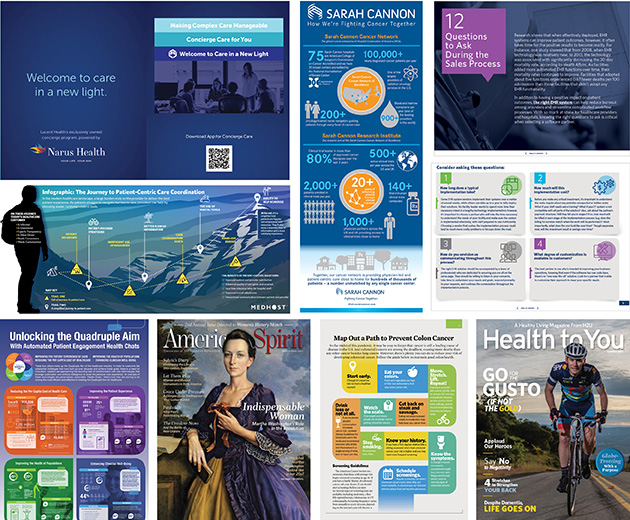



By John Lavey
By far, the most common question I receive from healthcare clients and prospective clients, or even friends when we talk about healthcare marketing, is: “What works?”
That question is really an umbrella for more specific questions, such as:
These are the essential questions any organization will have about its marketing, particularly for healthcare companies that are trying to market to hard-to-reach buyers in provider, payer and pharma organizations. So, what works? Here are three key places to start, based on your answers to the following questions:
Give us a call if you’d like to talk more about what isn’t working for you, and where you might start.
Image: Getty Images
About Hammock Healthcare Idea Email | This post is part of Hammock’s award-winning Idea Email series. Idea Emails are sent every other week and share one insightful marketing idea. Idea Email comes in two flavors: Original and Healthcare. To subscribe to the original Idea Email (general marketing ideas), click here. To subscribe to the Healthcare Idea Email (healthcare marketing ideas), click here.

By Megan Hamby, Editorial Director
In 1988, four men from Jamaica made history when they entered the bobsleigh race during the Winter Olympics in Calgary, Alberta, Canada. Jamaica—a country whose tropical climate keeps it warm year-round—had never competed in the Winter Games before. But after seeing a local pushcart derby, two American businessmen living in Jamaica proposed forming a bobsleigh team—and earned the support of the country’s Olympic Association.
Now, a Jamaican bobsleigh team is sure to attract attention no matter what. But when the U.S. ice hockey team was eliminated, American media stations needed to fill airtime—and chose to focus instead on the Jamaican bobsleigh team’s four-man event, leading even more people to learn of this unlikely team.
Jamaica’s appearance at the 1988 Winter Olympics inspired the 1993 movie Cool Runnings, which was a box office success and grossed $154.9 million worldwide.
Now, 34 years later, people still know about the Jamaican bobsleigh team that made history—despite not even placing in the top 10. Why? It’s an amazing story.
When we watch the Olympics from our living rooms, it can be hard to connect with the athletes. After all, not many of us can do backflips on a snowboard or a triple axel on the ice rink. But we may be better relate to the snowboarder who battles depression, the women’s bobsleigh world champion who is raising a child with Down syndrome, or the teenage skier who was adopted—and after we read or hear their stories, we’ll remember their names and root for them from our living room couch.
Author and inspirational speaker Simon Sinek once said, “People don’t buy what you do, they buy why you do it.”
When we hear Olympians’ stories, they become real people who face challenges, setbacks, disappointments and triumphs. We hear their stories and we learn their “why.”
So what does any of this have to do with marketing?
As marketers, we’re all constantly seeking out ways to connect with our audience. Storytelling should be a priority for marketers because it forms a human connection and elicits a response. Storytelling is a powerful tool for transmitting knowledge and information, and, when done correctly, it differentiates you from your competitors and makes you memorable to your customers.
As you settle in to watch the 2022 Winter Olympics, take a second to think about how you can tell your organization’s story—and give us a call for help.
Image: Getty Images
About Hammock Healthcare Idea Email | This post is part of Hammock’s award-winning Idea Email series. Idea Emails are sent every other week and share one insightful marketing idea. Idea Email comes in two flavors: Original and Healthcare. To subscribe to the original Idea Email (general marketing ideas), click here . To subscribe to the Healthcare Idea Email (healthcare marketing ideas), click here.

By Megan Hamby, Editorial Director
One of the biggest challenges that marketers face when creating new content is promoting and distributing that content. You’ve created campaigns with engaging blog posts, thought-provoking e-books and compelling infographics—but if you are not able to ensure your target audience sees it, then what good does it really do?
Generating qualified leads requires more than just publishing compelling content. You also need a strategy for promoting that content—focusing on all the tactics at your disposal to ensure your message reaches its intended audience. With healthcare, this isn’t a one-size-fits-all approach. Instead, your content strategy should be highly customized and you must leverage trusted channels—industry conferences, trade media or even your own events. Another option to include in your content strategy is paid media—a way to promote content through sponsored social media posts, native advertising, paid search results, video advertisements, display ads and more. Utilizing paid media can be an effective and efficient way to reach your target audience and expand your reach.
However, when it comes to paid media, simply using Google Search ads or pay-per-click ads likely won’t help you reach your target audience or key decision-makers. Instead, turn to more specific forms of paid media, such as:
This week, take a look at your content that could use an extra push—and look for new ways to distribute it with paid media. Need help? Give us a call.
Image: Getty Images
About Hammock Healthcare Idea Email | This post is part of Hammock’s award-winning Idea Email series. Idea Emails are sent every other week and share one insightful marketing idea. Idea Email comes in two flavors: Original and Healthcare. To subscribe to the original Idea Email (general marketing ideas), click here. To subscribe to the Healthcare Idea Email (healthcare marketing ideas), click here.

By Megan Hamby, Editorial Director
What comes to mind when you think of “content marketing”? Chances are, you’re thinking about blog posts, whitepapers, case studies, how-to guides and e-books. While content marketing is all of those things, it would be foolish not to consider visual mediums as content marketing.
As an editor and a writer, I naturally love the art of the written word. But in today’s digital age, it should come as no surprise that a whopping 65% of people are visual learners, according to the Social Science Research Network. Visual elements, such as video, presentations and infographics, help marketers connect with their audiences even faster—in fact, research shows that visuals are processed 60,000 times faster than text in the brain.
I don’t know about you, but those numbers convince me of the importance of visual storytelling and have me brainstorming ways to incorporate more visuals into the content we deliver for our clients.
Take video, for example. YouTube has more than 2 billion logged-in monthly users and is the world’s second-most visited website (right after Google, its parent company). Plus, research shows that more than 50% of B2B decision makers use YouTube to research purchases, making it the most-used social platform for this purpose.
Video has been an important storytelling medium for clients we’ve worked with to present their messages compellingly and memorably. With one client, we interviewed CEOs and executives from various companies, allowing them to tell their own stories to be used at a conference. The videos were more engaging for the audience than, say, a brochure with the executives’ bios and work history.
Another example of visual content includes infographics, which are a helpful way to synthesize data and information in an easy-to-digest format. Peppering a slide deck with visual aids, such as infographics, can help your audience retain information. Research shows that people who are asked to recall information after a three-day period retain only 10% of what they heard during an oral presentation; 35% from a visual presentation; and 65% from an oral presentation with visuals. The data speaks for itself: Visuals are a win.
As you kick off a new year, what’s on your content calendar that could benefit from a dynamic visual? Is it a blog post, accompanied by an infographic? An interview conducted on video or a how-to instructional video posted on your website? Or is it a presentation with 3D effects, infographics, powerful imagery and visually appealing colors?
This year, we challenge you to think outside the box when it comes to delivering content. Contact us today to learn how we can help you use visuals to yield better results for your organization.
Image: Getty Images
About Hammock Healthcare Idea Email | This post is part of Hammock’s award-winning Idea Email series. Idea Emails are sent every other week and share one insightful marketing idea. Idea Email comes in two flavors: Original and Healthcare. To subscribe to the original Idea Email (general marketing ideas), click here . To subscribe to the Healthcare Idea Email (healthcare marketing ideas), click here.

By John Lavey | Hammock President and COO
I spend most of my professional life helping clients tell stories across all forms of media to accomplish a business objective. But in my personal life for the past eight years, I’ve also been part of a few storytelling groups in Nashville and have gotten up on stage in bars and comedy clubs to tell comic stories.
Telling a story in front of a crowd has informed my perspective on marketing, and I’ve learned through great nights where I was killing it (and one or two nights where I’ve bombed) three truths about what it takes to engage an audience. I think those three truths are just as relevant for engaging your audience at a healthcare conference as they are in a club.
Storytelling and creating engagement with your ideas and solutions can be enhanced with attention to these tips, in my experience with clients, too, not just strangers in a comedy club. And that’s no joke.
Image: Getty Images
About Hammock Healthcare Idea Email | This post is part of Hammock’s award-winning Idea Email series. Idea Emails are sent every other week and share one insightful marketing idea. Idea Email comes in two flavors: Original and Healthcare. To subscribe to the original Idea Email (general marketing ideas), click here. To subscribe to the Healthcare Idea Email (healthcare marketing ideas), click here.

By: Rex Hammock, CEO
This year marks the 30th anniversary of the founding of Hammock Inc. As we were then, we continue to be a marketing services company that specializes in providing custom media to companies, associations and other types of organizations
Many marketers are surprised to learn that, 30 years ago, there were just a few dozen agencies focused exclusively on serving marketers who use media tools, channels and venues in ways that help their clients and customers develop long-term relationships with their customers and members.
Recurring print magazines were our first specialty.
But soon, we evolved and expanded our services, providing a wide array of media to serve innovative marketers who use all forms of print and digital media.
Over the years, our clients have ranged from century-old magazines to startup healthcare companies. And our services have pivoted (as it is called these days) to provide an endless array of solutions, services, campaigns, recurring publications, video and, well, you get the picture.
To help give our friends a look into what we do, we decided to share some examples of the parts that can fit together to create—with our clients—effective content marketing solutions and desired results.
But we don’t view these as fill-in-the-blank projects and capabilities. To us, each one of these works represents a unique and strategic partnership custom media-designed and created to solve specific challenges and opportunities. Together they represent three decades of custom content that reminds us of the millions of customers, viewers, readers, members and supporters of organizations that our clients have given us the opportunity to serve, while creating and growing relationships that stand the test of time.

Association magazines (print and digital)
Employee magazines (print and digital)
Advertising sales
Books (print and e-books)
Blogs
Presentations
Infographics
Video
Websites and projects
Newsletters (print and digital)
Conference media
Conference ad sales
Creative design & direction
Employee media
And much more …
To learn more about marrying art and content to share your message, give us a call. We’d love to share examples of how we’ve solved challenges like yours.
About Hammock Healthcare Idea Email | This post is part of Hammock’s award-winning Idea Email series. Idea Emails are sent every other week and share one insightful marketing idea. Idea Email comes in two flavors: Original and Healthcare. To subscribe to the original Idea Email (general marketing ideas), click here . To subscribe to the Healthcare Idea Email (healthcare marketing ideas), click here.

By John Lavey | Hammock President and COO
It used to be in the marketing agency world that you wanted to be all things to all people, and have everything under one roof. The problem with that model is that it may not enable you to match client needs with the best solution. You are able only to match client needs with the best solution you have in-house. It often results in generalists tasked with meeting highly specific needs.
That is a particular problem for healthcare. The breadth and depth of this industry require a keen understanding of the challenges at all levels—in particular where the topics are clinical, financial and technical. A writer who understands how to write an article about heart health for a consumer audience isn’t always the same fit for content about pharma technology aimed at a financial decision maker.
As rapidly as the world of marketing is evolving and changing, at Hammock we see the need to find the best-in-class provider of services every single time: writers who are specialists in their field; photographers and videographers able to be deployed on a moment’s notice where they live; experts in preferred marketing automation platforms used by clients; paid push specialists with experience in the client’s industry.
We’ve made a business out of ensuring core competencies are in-house and then working with the best people in their respective disciplines, who are contractors to us on projects and recurring contracted work, and utilizing tried-and-true processes and platforms to ensure our control over workflows and our ability to provide the best client experience and deliver the best results.
We’ve used this method of delivering award-winning marketing media for 30 years, and worked with hundreds of team members outside our walls along the way. In a recent get-to-know-you call, while I was explaining what we do, the prospective client beat me to the punch line: “So, your company has ‘The Hollywood Model?’” Yes, indeed.
Movies and TVs have been made for decades by companies that gather subspecialties to serve on teams to execute the most entertaining content we all enjoy. In our view, it’s the most successful and efficient way to meet our clients’ needs.
Do you want specialists or generalists serving your marketing needs? Welcome to Hollywood.
Image: Getty Images
About Hammock Healthcare Idea Email | This post is part of Hammock’s award-winning Idea Email series. Idea Emails are sent every other week and share one insightful marketing idea. Idea Email comes in two flavors: Original and Healthcare. To subscribe to the original Idea Email (general marketing ideas), click here. To subscribe to the Healthcare Idea Email (healthcare marketing ideas), click here.

By: John Lavey | Hammock President/COO
It used to be in the marketing agency world that you wanted to be all things to all people, and have everything under one roof. The problem with that model is that it may not enable you to match client needs with the best solution. You are able only to match client needs with the best solution you have in-house. It often results in generalists tasked with meeting highly specific needs.
As rapidly as the world of marketing is evolving and changing, at Hammock we see the need to find the best-in-class provider of services every single time: writers who are specialists in their field; photographers and videographers able to be deployed on a moment’s notice where they live; experts in preferred marketing automation platforms used by clients; paid push specialists with experience in the client’s industry.
We’ve made a business out of ensuring core competencies are in-house and then working with the best people in their respective disciplines, who are contractors to us on projects and recurring contracted work, and utilizing tried-and-true processes and platforms to ensure our control over workflows and our ability to provide the best client experience and deliver the best results.
We’ve used this method of delivering award-winning marketing media for 30 years, and worked with hundreds of team members outside our walls along the way. In a get-to-know-you call last week, while I was explaining what we do, the prospective client beat me to the punch line: “So, your company has ‘The Hollywood Model?’” Yes, indeed.
Movies and TVs have been made for decades by companies that gather subspecialties to serve on teams to execute the most entertaining content we all enjoy. In our view, it’s the most successful and efficient way to meet our clients’ needs.
Do you want specialists or generalists serving your marketing needs? Welcome to Hollywood.
Photo: Getty Images
About Hammock Healthcare Idea Email | This post is part of Hammock’s award-winning Idea Email series. Idea Emails are sent every other week and share one insightful marketing idea. Idea Email comes in two flavors: Original and Healthcare. To subscribe to the original Idea Email (general marketing ideas), click here . To subscribe to the Healthcare Idea Email (healthcare marketing ideas), click here.

By John Lavey | Hammock President and COO
My conversations with healthcare organizations—providers, payers, pharma companies, technology or service solutions—show me that the marketers within those organizations need more help understanding the industry that is there to support their efforts.
When Hammock was founded 30 years ago, we were not known as a marketing company. We were known as a custom publishing company. At the time, it was appropriate for describing what we did: creating recurring custom-published marketing media for clients (which they owned) to accomplish a business objective.
It also helped explain how we were different from advertising agencies or public relations (PR) firms. Our work went directly to customers and prospects. Advertising and PR were piggybacking on someone else’s published media to reach customers and prospects.
During the Great Recession (2007–2009) many print newspapers and magazines collapsed. Traditional advertising agencies and PR firms also took a hit when those media failed.
The vocabulary to describe what we do to help clients communicate and grow started changing. For example, the industry organization Rex Hammock co-founded in 1998, the Custom Publishing Council, became the Custom Content Council.
Advertising and PR functions are still critical, of course. One consideration is who has expertise in going direct to audiences, and who is there to help efforts using someone else’s media?
We’ve evolved new capabilities and embraced new media, from digital to video to social. But where we add value is the same today as it was in 1991. We help support and nurture the customer journey, before they are a customer, and afterward. We deliver strategy and implementation, as well as measurement of key performance indicators, and we help our clients establish themselves as thought leaders in their respective fields.
Everybody has a story to tell, a message to deliver, and we specialize in helping you take yours directly to the people who need to hear, read or view it so that you can continue to grow.
Image: Getty Images
About Hammock Healthcare Idea Email | This post is part of Hammock’s award-winning Idea Email series. Idea Emails are sent every other week and share one insightful marketing idea. Idea Email comes in two flavors: Original and Healthcare. To subscribe to the original Idea Email (general marketing ideas), click here. To subscribe to the Healthcare Idea Email (healthcare marketing ideas), click here.

By John Lavey | Hammock President and COO
Image: Getty Images
About Hammock Healthcare Idea Email | This post is part of Hammock’s award-winning Idea Email series. Idea Emails are sent every other week and share one insightful marketing idea. Idea Email comes in two flavors: Original and Healthcare. To subscribe to the original Idea Email (general marketing ideas), click here. To subscribe to the Healthcare Idea Email (healthcare marketing ideas), click here.